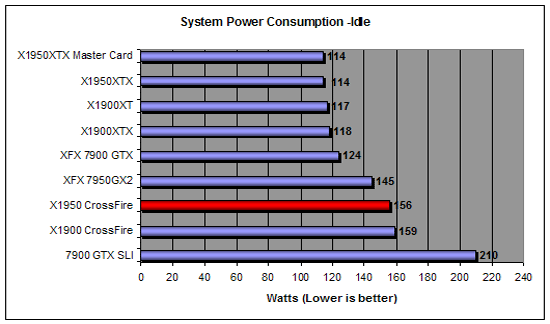ATI Radeon X1950XTX CrossFire Review
Power Consumption & Conclusion
Power Consumption
For testing power consumption we took our test system and plugged it into a Seasonic Power Angel. For idle numbers we allowed the system to idle on the desktop for 5 minutes and took the reading. For load numbers we measured the peak wattage used by the sytem while running through 3DMark 2006.

The 7900GTX seems to eat quite a bit more power at idle than any other system we tested here. The X1950 CrossFire system seems to have dropped a few watts compared to X1900 CrossFire and every little bit counts!

Whoa! The two CrossFire systems are using up some serious power. The X1950’s in CrossFire have dropped 24w from the X1900’s. This is a significant drop but the system is still using 400w. The 7950GX2 is very impressive consuming only 265w at full load.
Conclusion:
ATI’s CrossFire gets a nice bump in performance with the X1950 and is a blazing fast system, but in our testing it is still not enough to lay claim to the fastest multi-gpu system. When it works it does work well but really needs to be more consistent. I suppose that the problem is that the X1950 single card is so damn good at stomping the competition that it makes CrossFire look less than stellar. SLI was designed into the PCI-Express GeForce cards from the start and it still shows despite massive improvements by ATI. As we pointed out in the world Multi-GPU article ATI has made great strides to make CrossFire better. We actually see better scaling and ease of use from the lower end CrossFire systems that don’t need the dongle to operate, and is a clear indication of what the future holds for CrossFire.
While 7900GTX SLI is the leader in realm of 2 video cards, our recommendation is still for the 7950GX2. This recommendation is not without reservations, you need to do your homework to make sure you have a motherboard and BIOS that will work correctly with the card or at least have something on standby to get your board useable with the card. Recent price drops put reference models near the $500 mark which is just too good to pass up if you want to venture into serious video card performance.
Brian’s thoughts:
As stated in the review yesterday, the new heatsink is a truly welcome sight and when paired up in CrossFire ATI’s efforts on the new cooling unit really shine. Without sounding like a personal rant, it took a lot of tolerance to install CrossFire X1800XT and X1900XTX because the slave card heatsink was going berserk until the driver loaded. This was especially annoying if you happened to be doing a fresh Windows XP installation. With the X1950XTX the heatsinks give a very quick rev when the power button is pushed and you don’t hear much else from them.
ATI is really pushing to make CrossFire more user friendly. Every few driver revisions it becomes just a little easier to install. While it’s not quite to the level of SLI with the pop up balloon tip, it is slowly getting closer.
I’m still very much on the fence about suggesting high end multi-GPU solutions and only recommend them for those with 24″ or 30″ monitors. While it’s nice having two video cards to deliver butter smooth gaming performance the heat generated by two high end cards is enough to raise the temperature of a small bedroom or dorm room to an uncomfortable level after just an hour of gaming.
Legit Bottom Line: The X1950 CrossFire builds upon the performance of X1900 CrossFire, adds better cooling, and lowers power consumption. It’s a smoking fast solution proving that it’s all about hot, nasty, bad ass speed.

Comments are closed.